HI6028 Taxation Law T1 2018: Case Study on Arthur Murray & RIP Pty Ltd
VerifiedAdded on 2023/06/11
|14
|3565
|393
Case Study
AI Summary
This assignment provides a detailed analysis of taxation law, primarily focusing on the Arthur Murray (NSW) Pty Ltd v FCT case and its implications, along with a practical application through the case of RIP Pty Ltd, a funeral services company. The analysis covers key issues such as income derivation, the choice between cash and accruals accounting methods, and the treatment of prepaid and forfeited fees. It also delves into the definition and treatment of trading stock under the ITAA 1997, offering a comprehensive overview of relevant taxation principles and their application in real-world business scenarios. The document further discusses the tax implications related to various aspects of RIP Pty Ltd's operations, including Easy Future Plan and trading stock valuation. Desklib offers a platform to access similar solved assignments and past papers for students.
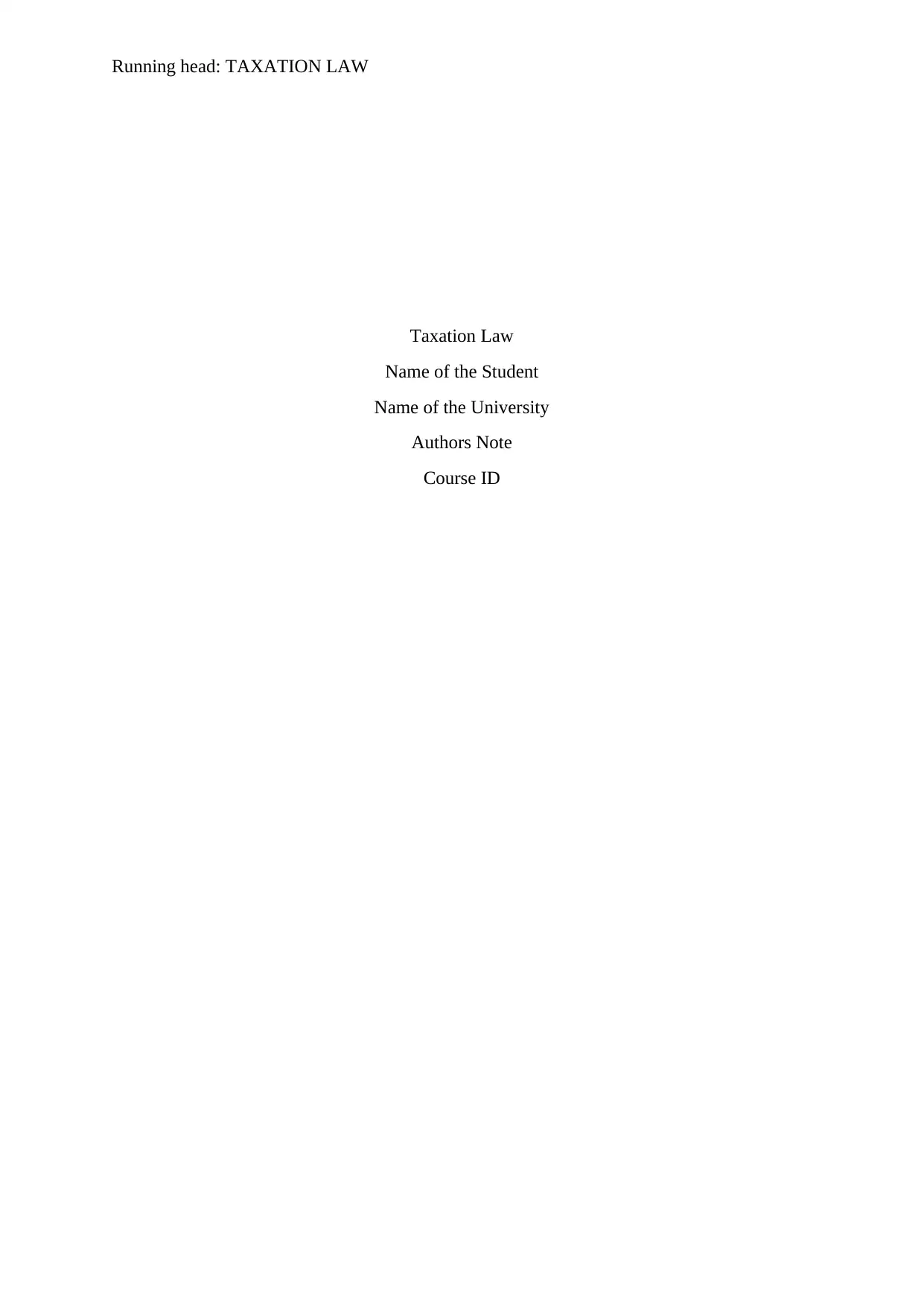
Running head: TAXATION LAW
Taxation Law
Name of the Student
Name of the University
Authors Note
Course ID
Taxation Law
Name of the Student
Name of the University
Authors Note
Course ID
Paraphrase This Document
Need a fresh take? Get an instant paraphrase of this document with our AI Paraphraser
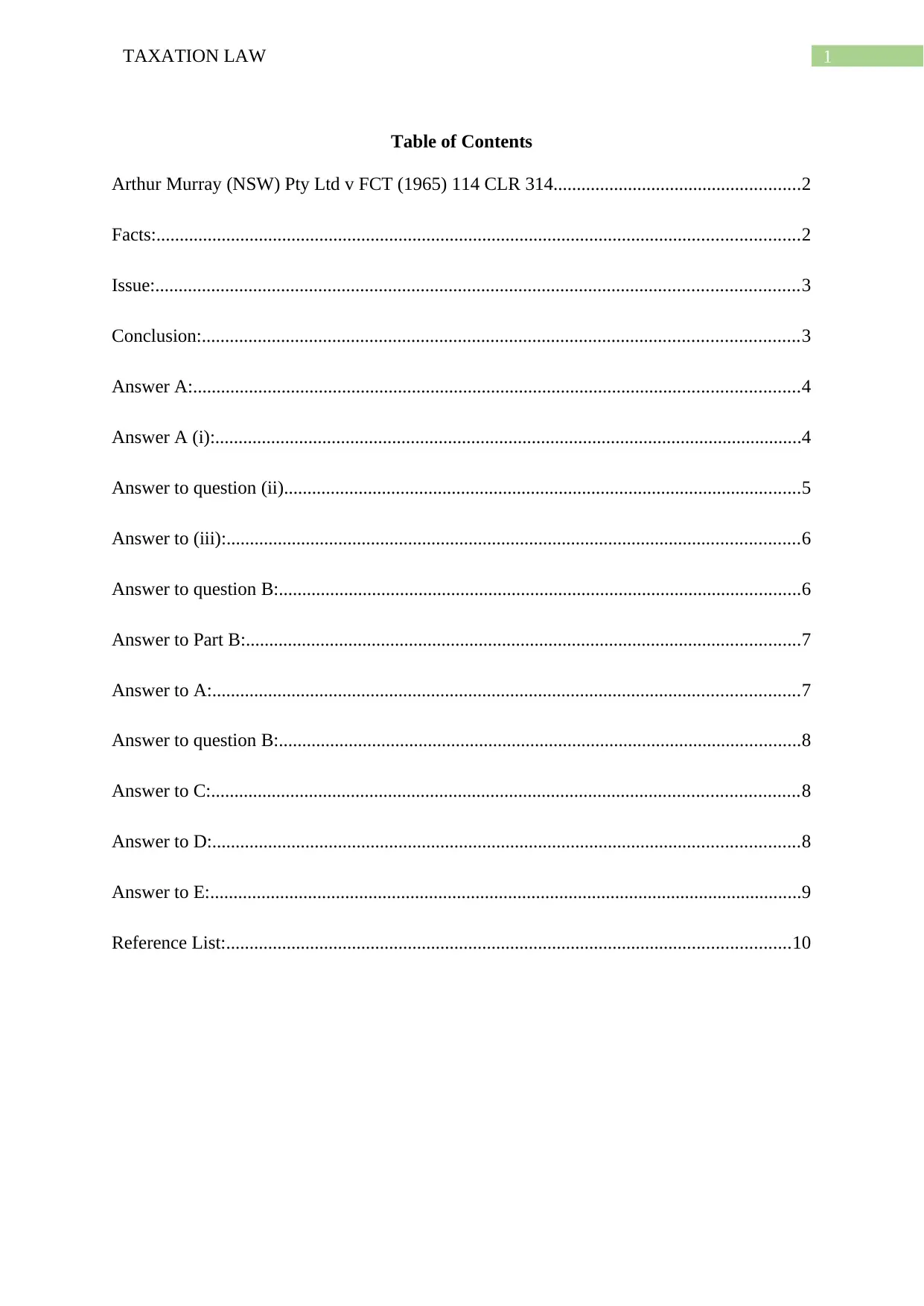
1TAXATION LAW
Table of Contents
Arthur Murray (NSW) Pty Ltd v FCT (1965) 114 CLR 314.....................................................2
Facts:..........................................................................................................................................2
Issue:..........................................................................................................................................3
Conclusion:................................................................................................................................3
Answer A:..................................................................................................................................4
Answer A (i):..............................................................................................................................4
Answer to question (ii)...............................................................................................................5
Answer to (iii):...........................................................................................................................6
Answer to question B:................................................................................................................6
Answer to Part B:.......................................................................................................................7
Answer to A:..............................................................................................................................7
Answer to question B:................................................................................................................8
Answer to C:..............................................................................................................................8
Answer to D:..............................................................................................................................8
Answer to E:...............................................................................................................................9
Reference List:.........................................................................................................................10
Table of Contents
Arthur Murray (NSW) Pty Ltd v FCT (1965) 114 CLR 314.....................................................2
Facts:..........................................................................................................................................2
Issue:..........................................................................................................................................3
Conclusion:................................................................................................................................3
Answer A:..................................................................................................................................4
Answer A (i):..............................................................................................................................4
Answer to question (ii)...............................................................................................................5
Answer to (iii):...........................................................................................................................6
Answer to question B:................................................................................................................6
Answer to Part B:.......................................................................................................................7
Answer to A:..............................................................................................................................7
Answer to question B:................................................................................................................8
Answer to C:..............................................................................................................................8
Answer to D:..............................................................................................................................8
Answer to E:...............................................................................................................................9
Reference List:.........................................................................................................................10
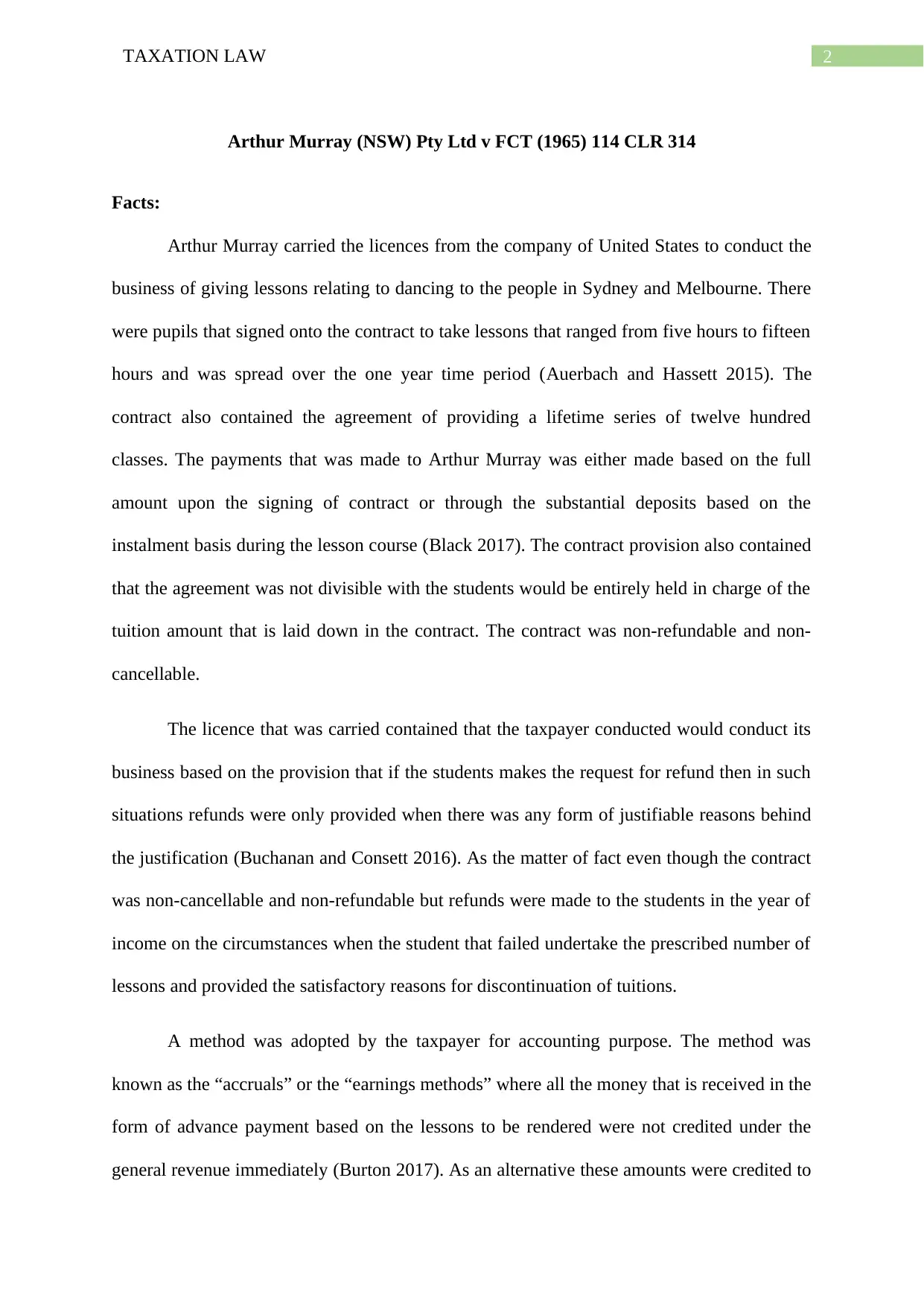
2TAXATION LAW
Arthur Murray (NSW) Pty Ltd v FCT (1965) 114 CLR 314
Facts:
Arthur Murray carried the licences from the company of United States to conduct the
business of giving lessons relating to dancing to the people in Sydney and Melbourne. There
were pupils that signed onto the contract to take lessons that ranged from five hours to fifteen
hours and was spread over the one year time period (Auerbach and Hassett 2015). The
contract also contained the agreement of providing a lifetime series of twelve hundred
classes. The payments that was made to Arthur Murray was either made based on the full
amount upon the signing of contract or through the substantial deposits based on the
instalment basis during the lesson course (Black 2017). The contract provision also contained
that the agreement was not divisible with the students would be entirely held in charge of the
tuition amount that is laid down in the contract. The contract was non-refundable and non-
cancellable.
The licence that was carried contained that the taxpayer conducted would conduct its
business based on the provision that if the students makes the request for refund then in such
situations refunds were only provided when there was any form of justifiable reasons behind
the justification (Buchanan and Consett 2016). As the matter of fact even though the contract
was non-cancellable and non-refundable but refunds were made to the students in the year of
income on the circumstances when the student that failed undertake the prescribed number of
lessons and provided the satisfactory reasons for discontinuation of tuitions.
A method was adopted by the taxpayer for accounting purpose. The method was
known as the “accruals” or the “earnings methods” where all the money that is received in the
form of advance payment based on the lessons to be rendered were not credited under the
general revenue immediately (Burton 2017). As an alternative these amounts were credited to
Arthur Murray (NSW) Pty Ltd v FCT (1965) 114 CLR 314
Facts:
Arthur Murray carried the licences from the company of United States to conduct the
business of giving lessons relating to dancing to the people in Sydney and Melbourne. There
were pupils that signed onto the contract to take lessons that ranged from five hours to fifteen
hours and was spread over the one year time period (Auerbach and Hassett 2015). The
contract also contained the agreement of providing a lifetime series of twelve hundred
classes. The payments that was made to Arthur Murray was either made based on the full
amount upon the signing of contract or through the substantial deposits based on the
instalment basis during the lesson course (Black 2017). The contract provision also contained
that the agreement was not divisible with the students would be entirely held in charge of the
tuition amount that is laid down in the contract. The contract was non-refundable and non-
cancellable.
The licence that was carried contained that the taxpayer conducted would conduct its
business based on the provision that if the students makes the request for refund then in such
situations refunds were only provided when there was any form of justifiable reasons behind
the justification (Buchanan and Consett 2016). As the matter of fact even though the contract
was non-cancellable and non-refundable but refunds were made to the students in the year of
income on the circumstances when the student that failed undertake the prescribed number of
lessons and provided the satisfactory reasons for discontinuation of tuitions.
A method was adopted by the taxpayer for accounting purpose. The method was
known as the “accruals” or the “earnings methods” where all the money that is received in the
form of advance payment based on the lessons to be rendered were not credited under the
general revenue immediately (Burton 2017). As an alternative these amounts were credited to
⊘ This is a preview!⊘
Do you want full access?
Subscribe today to unlock all pages.

Trusted by 1+ million students worldwide
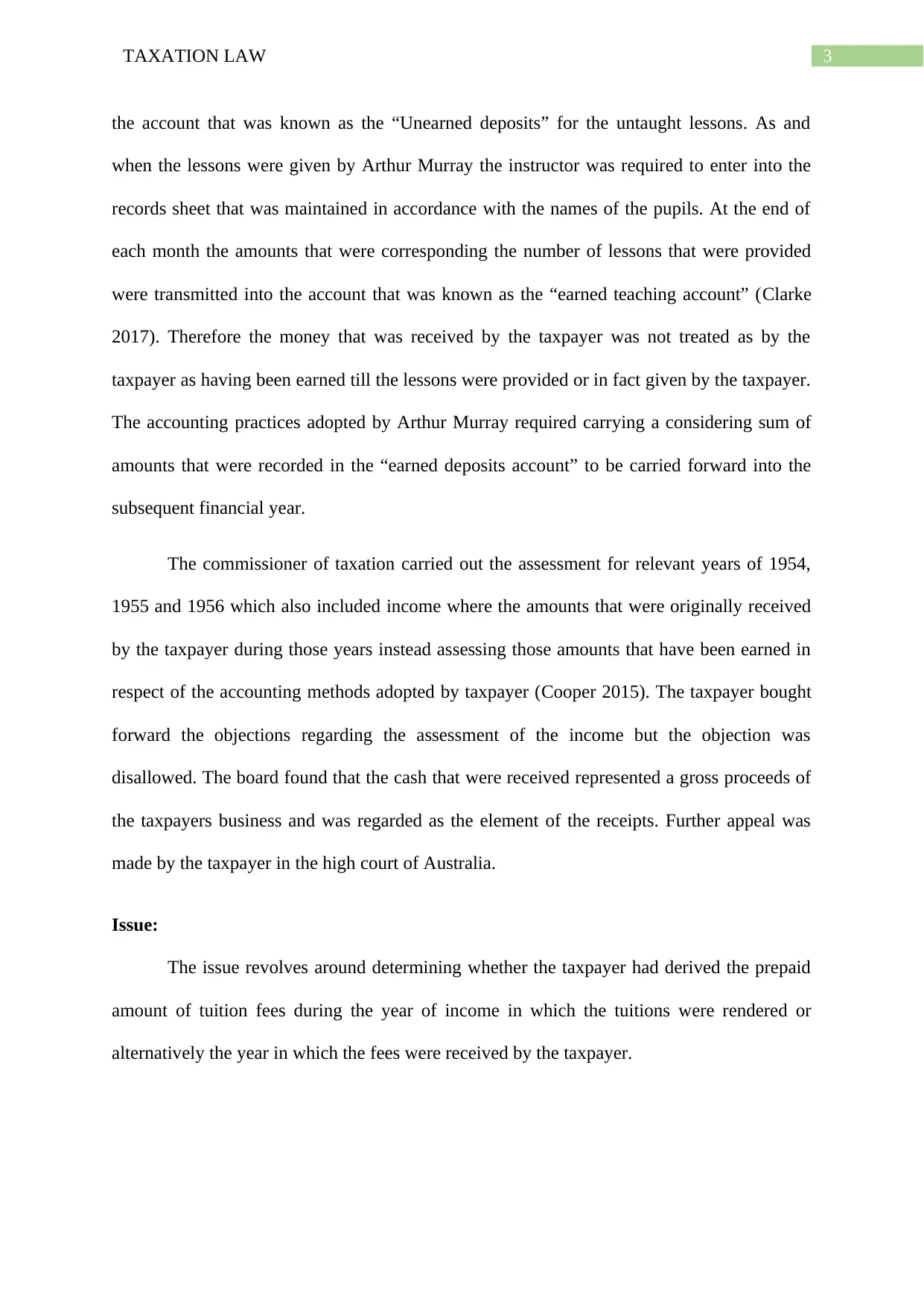
3TAXATION LAW
the account that was known as the “Unearned deposits” for the untaught lessons. As and
when the lessons were given by Arthur Murray the instructor was required to enter into the
records sheet that was maintained in accordance with the names of the pupils. At the end of
each month the amounts that were corresponding the number of lessons that were provided
were transmitted into the account that was known as the “earned teaching account” (Clarke
2017). Therefore the money that was received by the taxpayer was not treated as by the
taxpayer as having been earned till the lessons were provided or in fact given by the taxpayer.
The accounting practices adopted by Arthur Murray required carrying a considering sum of
amounts that were recorded in the “earned deposits account” to be carried forward into the
subsequent financial year.
The commissioner of taxation carried out the assessment for relevant years of 1954,
1955 and 1956 which also included income where the amounts that were originally received
by the taxpayer during those years instead assessing those amounts that have been earned in
respect of the accounting methods adopted by taxpayer (Cooper 2015). The taxpayer bought
forward the objections regarding the assessment of the income but the objection was
disallowed. The board found that the cash that were received represented a gross proceeds of
the taxpayers business and was regarded as the element of the receipts. Further appeal was
made by the taxpayer in the high court of Australia.
Issue:
The issue revolves around determining whether the taxpayer had derived the prepaid
amount of tuition fees during the year of income in which the tuitions were rendered or
alternatively the year in which the fees were received by the taxpayer.
the account that was known as the “Unearned deposits” for the untaught lessons. As and
when the lessons were given by Arthur Murray the instructor was required to enter into the
records sheet that was maintained in accordance with the names of the pupils. At the end of
each month the amounts that were corresponding the number of lessons that were provided
were transmitted into the account that was known as the “earned teaching account” (Clarke
2017). Therefore the money that was received by the taxpayer was not treated as by the
taxpayer as having been earned till the lessons were provided or in fact given by the taxpayer.
The accounting practices adopted by Arthur Murray required carrying a considering sum of
amounts that were recorded in the “earned deposits account” to be carried forward into the
subsequent financial year.
The commissioner of taxation carried out the assessment for relevant years of 1954,
1955 and 1956 which also included income where the amounts that were originally received
by the taxpayer during those years instead assessing those amounts that have been earned in
respect of the accounting methods adopted by taxpayer (Cooper 2015). The taxpayer bought
forward the objections regarding the assessment of the income but the objection was
disallowed. The board found that the cash that were received represented a gross proceeds of
the taxpayers business and was regarded as the element of the receipts. Further appeal was
made by the taxpayer in the high court of Australia.
Issue:
The issue revolves around determining whether the taxpayer had derived the prepaid
amount of tuition fees during the year of income in which the tuitions were rendered or
alternatively the year in which the fees were received by the taxpayer.
Paraphrase This Document
Need a fresh take? Get an instant paraphrase of this document with our AI Paraphraser
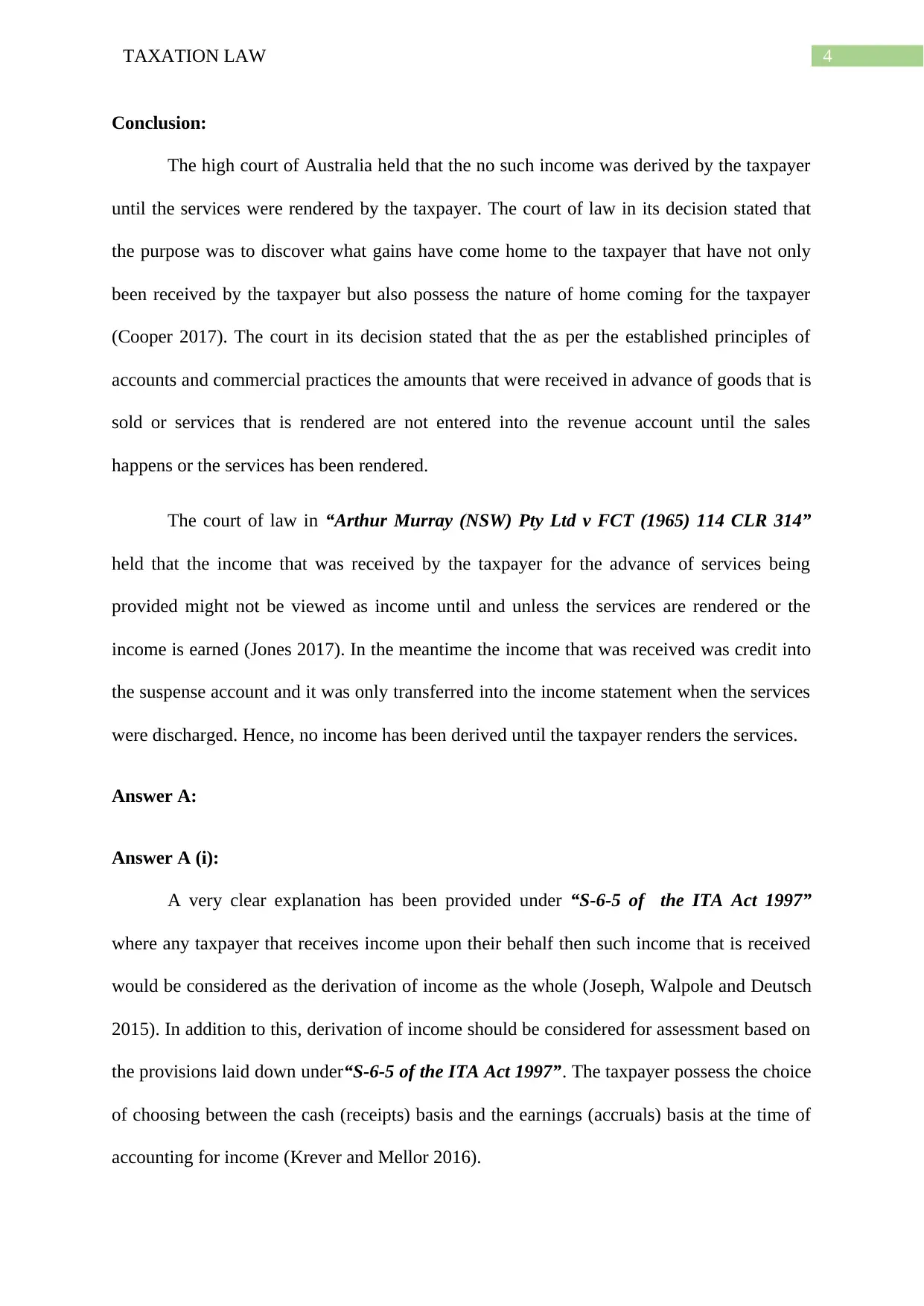
4TAXATION LAW
Conclusion:
The high court of Australia held that the no such income was derived by the taxpayer
until the services were rendered by the taxpayer. The court of law in its decision stated that
the purpose was to discover what gains have come home to the taxpayer that have not only
been received by the taxpayer but also possess the nature of home coming for the taxpayer
(Cooper 2017). The court in its decision stated that the as per the established principles of
accounts and commercial practices the amounts that were received in advance of goods that is
sold or services that is rendered are not entered into the revenue account until the sales
happens or the services has been rendered.
The court of law in “Arthur Murray (NSW) Pty Ltd v FCT (1965) 114 CLR 314”
held that the income that was received by the taxpayer for the advance of services being
provided might not be viewed as income until and unless the services are rendered or the
income is earned (Jones 2017). In the meantime the income that was received was credit into
the suspense account and it was only transferred into the income statement when the services
were discharged. Hence, no income has been derived until the taxpayer renders the services.
Answer A:
Answer A (i):
A very clear explanation has been provided under “S-6-5 of the ITA Act 1997”
where any taxpayer that receives income upon their behalf then such income that is received
would be considered as the derivation of income as the whole (Joseph, Walpole and Deutsch
2015). In addition to this, derivation of income should be considered for assessment based on
the provisions laid down under“S-6-5 of the ITA Act 1997”. The taxpayer possess the choice
of choosing between the cash (receipts) basis and the earnings (accruals) basis at the time of
accounting for income (Krever and Mellor 2016).
Conclusion:
The high court of Australia held that the no such income was derived by the taxpayer
until the services were rendered by the taxpayer. The court of law in its decision stated that
the purpose was to discover what gains have come home to the taxpayer that have not only
been received by the taxpayer but also possess the nature of home coming for the taxpayer
(Cooper 2017). The court in its decision stated that the as per the established principles of
accounts and commercial practices the amounts that were received in advance of goods that is
sold or services that is rendered are not entered into the revenue account until the sales
happens or the services has been rendered.
The court of law in “Arthur Murray (NSW) Pty Ltd v FCT (1965) 114 CLR 314”
held that the income that was received by the taxpayer for the advance of services being
provided might not be viewed as income until and unless the services are rendered or the
income is earned (Jones 2017). In the meantime the income that was received was credit into
the suspense account and it was only transferred into the income statement when the services
were discharged. Hence, no income has been derived until the taxpayer renders the services.
Answer A:
Answer A (i):
A very clear explanation has been provided under “S-6-5 of the ITA Act 1997”
where any taxpayer that receives income upon their behalf then such income that is received
would be considered as the derivation of income as the whole (Joseph, Walpole and Deutsch
2015). In addition to this, derivation of income should be considered for assessment based on
the provisions laid down under“S-6-5 of the ITA Act 1997”. The taxpayer possess the choice
of choosing between the cash (receipts) basis and the earnings (accruals) basis at the time of
accounting for income (Krever and Mellor 2016).
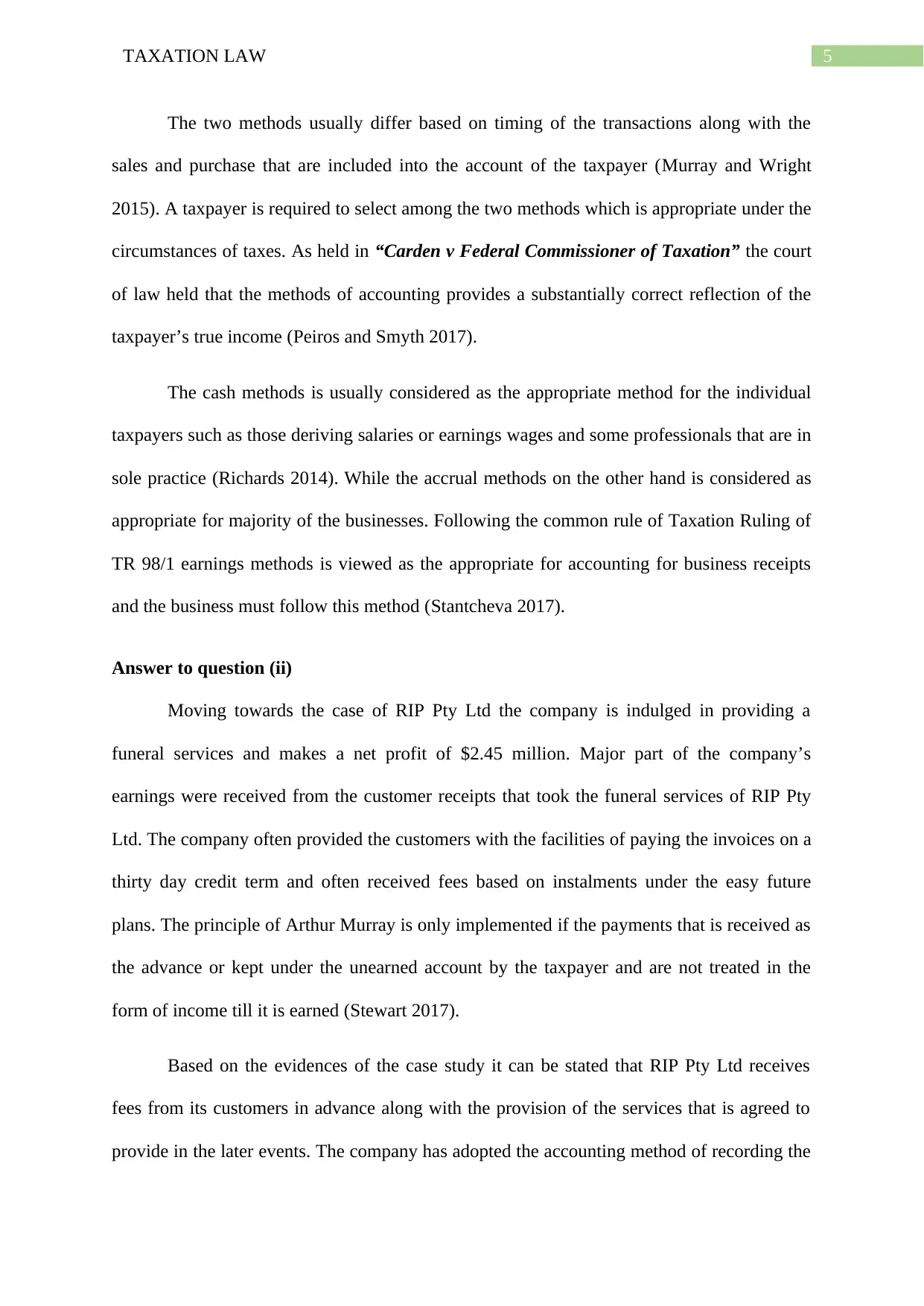
5TAXATION LAW
The two methods usually differ based on timing of the transactions along with the
sales and purchase that are included into the account of the taxpayer (Murray and Wright
2015). A taxpayer is required to select among the two methods which is appropriate under the
circumstances of taxes. As held in “Carden v Federal Commissioner of Taxation” the court
of law held that the methods of accounting provides a substantially correct reflection of the
taxpayer’s true income (Peiros and Smyth 2017).
The cash methods is usually considered as the appropriate method for the individual
taxpayers such as those deriving salaries or earnings wages and some professionals that are in
sole practice (Richards 2014). While the accrual methods on the other hand is considered as
appropriate for majority of the businesses. Following the common rule of Taxation Ruling of
TR 98/1 earnings methods is viewed as the appropriate for accounting for business receipts
and the business must follow this method (Stantcheva 2017).
Answer to question (ii)
Moving towards the case of RIP Pty Ltd the company is indulged in providing a
funeral services and makes a net profit of $2.45 million. Major part of the company’s
earnings were received from the customer receipts that took the funeral services of RIP Pty
Ltd. The company often provided the customers with the facilities of paying the invoices on a
thirty day credit term and often received fees based on instalments under the easy future
plans. The principle of Arthur Murray is only implemented if the payments that is received as
the advance or kept under the unearned account by the taxpayer and are not treated in the
form of income till it is earned (Stewart 2017).
Based on the evidences of the case study it can be stated that RIP Pty Ltd receives
fees from its customers in advance along with the provision of the services that is agreed to
provide in the later events. The company has adopted the accounting method of recording the
The two methods usually differ based on timing of the transactions along with the
sales and purchase that are included into the account of the taxpayer (Murray and Wright
2015). A taxpayer is required to select among the two methods which is appropriate under the
circumstances of taxes. As held in “Carden v Federal Commissioner of Taxation” the court
of law held that the methods of accounting provides a substantially correct reflection of the
taxpayer’s true income (Peiros and Smyth 2017).
The cash methods is usually considered as the appropriate method for the individual
taxpayers such as those deriving salaries or earnings wages and some professionals that are in
sole practice (Richards 2014). While the accrual methods on the other hand is considered as
appropriate for majority of the businesses. Following the common rule of Taxation Ruling of
TR 98/1 earnings methods is viewed as the appropriate for accounting for business receipts
and the business must follow this method (Stantcheva 2017).
Answer to question (ii)
Moving towards the case of RIP Pty Ltd the company is indulged in providing a
funeral services and makes a net profit of $2.45 million. Major part of the company’s
earnings were received from the customer receipts that took the funeral services of RIP Pty
Ltd. The company often provided the customers with the facilities of paying the invoices on a
thirty day credit term and often received fees based on instalments under the easy future
plans. The principle of Arthur Murray is only implemented if the payments that is received as
the advance or kept under the unearned account by the taxpayer and are not treated in the
form of income till it is earned (Stewart 2017).
Based on the evidences of the case study it can be stated that RIP Pty Ltd receives
fees from its customers in advance along with the provision of the services that is agreed to
provide in the later events. The company has adopted the accounting method of recording the
⊘ This is a preview!⊘
Do you want full access?
Subscribe today to unlock all pages.

Trusted by 1+ million students worldwide
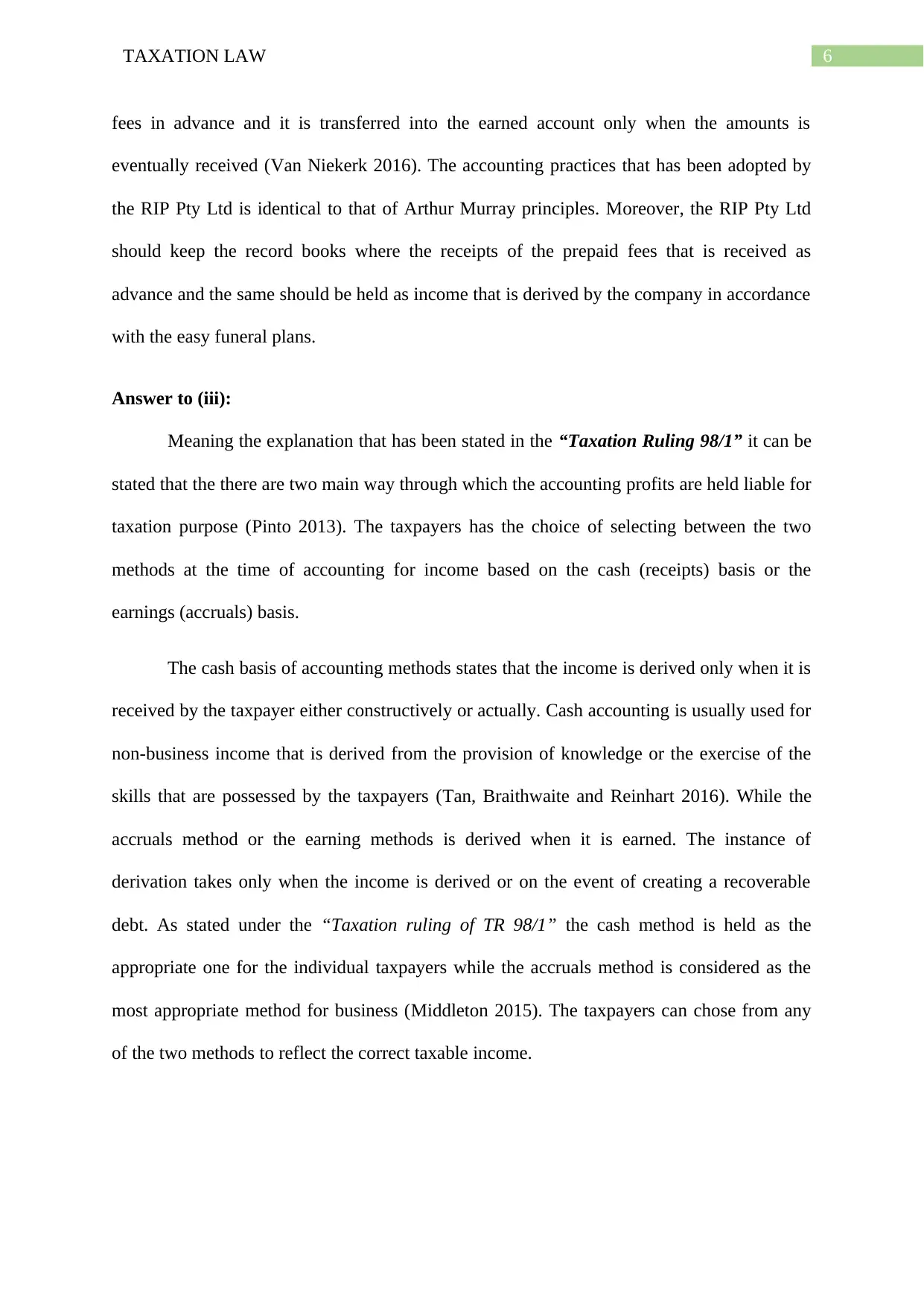
6TAXATION LAW
fees in advance and it is transferred into the earned account only when the amounts is
eventually received (Van Niekerk 2016). The accounting practices that has been adopted by
the RIP Pty Ltd is identical to that of Arthur Murray principles. Moreover, the RIP Pty Ltd
should keep the record books where the receipts of the prepaid fees that is received as
advance and the same should be held as income that is derived by the company in accordance
with the easy funeral plans.
Answer to (iii):
Meaning the explanation that has been stated in the “Taxation Ruling 98/1” it can be
stated that the there are two main way through which the accounting profits are held liable for
taxation purpose (Pinto 2013). The taxpayers has the choice of selecting between the two
methods at the time of accounting for income based on the cash (receipts) basis or the
earnings (accruals) basis.
The cash basis of accounting methods states that the income is derived only when it is
received by the taxpayer either constructively or actually. Cash accounting is usually used for
non-business income that is derived from the provision of knowledge or the exercise of the
skills that are possessed by the taxpayers (Tan, Braithwaite and Reinhart 2016). While the
accruals method or the earning methods is derived when it is earned. The instance of
derivation takes only when the income is derived or on the event of creating a recoverable
debt. As stated under the “Taxation ruling of TR 98/1” the cash method is held as the
appropriate one for the individual taxpayers while the accruals method is considered as the
most appropriate method for business (Middleton 2015). The taxpayers can chose from any
of the two methods to reflect the correct taxable income.
fees in advance and it is transferred into the earned account only when the amounts is
eventually received (Van Niekerk 2016). The accounting practices that has been adopted by
the RIP Pty Ltd is identical to that of Arthur Murray principles. Moreover, the RIP Pty Ltd
should keep the record books where the receipts of the prepaid fees that is received as
advance and the same should be held as income that is derived by the company in accordance
with the easy funeral plans.
Answer to (iii):
Meaning the explanation that has been stated in the “Taxation Ruling 98/1” it can be
stated that the there are two main way through which the accounting profits are held liable for
taxation purpose (Pinto 2013). The taxpayers has the choice of selecting between the two
methods at the time of accounting for income based on the cash (receipts) basis or the
earnings (accruals) basis.
The cash basis of accounting methods states that the income is derived only when it is
received by the taxpayer either constructively or actually. Cash accounting is usually used for
non-business income that is derived from the provision of knowledge or the exercise of the
skills that are possessed by the taxpayers (Tan, Braithwaite and Reinhart 2016). While the
accruals method or the earning methods is derived when it is earned. The instance of
derivation takes only when the income is derived or on the event of creating a recoverable
debt. As stated under the “Taxation ruling of TR 98/1” the cash method is held as the
appropriate one for the individual taxpayers while the accruals method is considered as the
most appropriate method for business (Middleton 2015). The taxpayers can chose from any
of the two methods to reflect the correct taxable income.
Paraphrase This Document
Need a fresh take? Get an instant paraphrase of this document with our AI Paraphraser
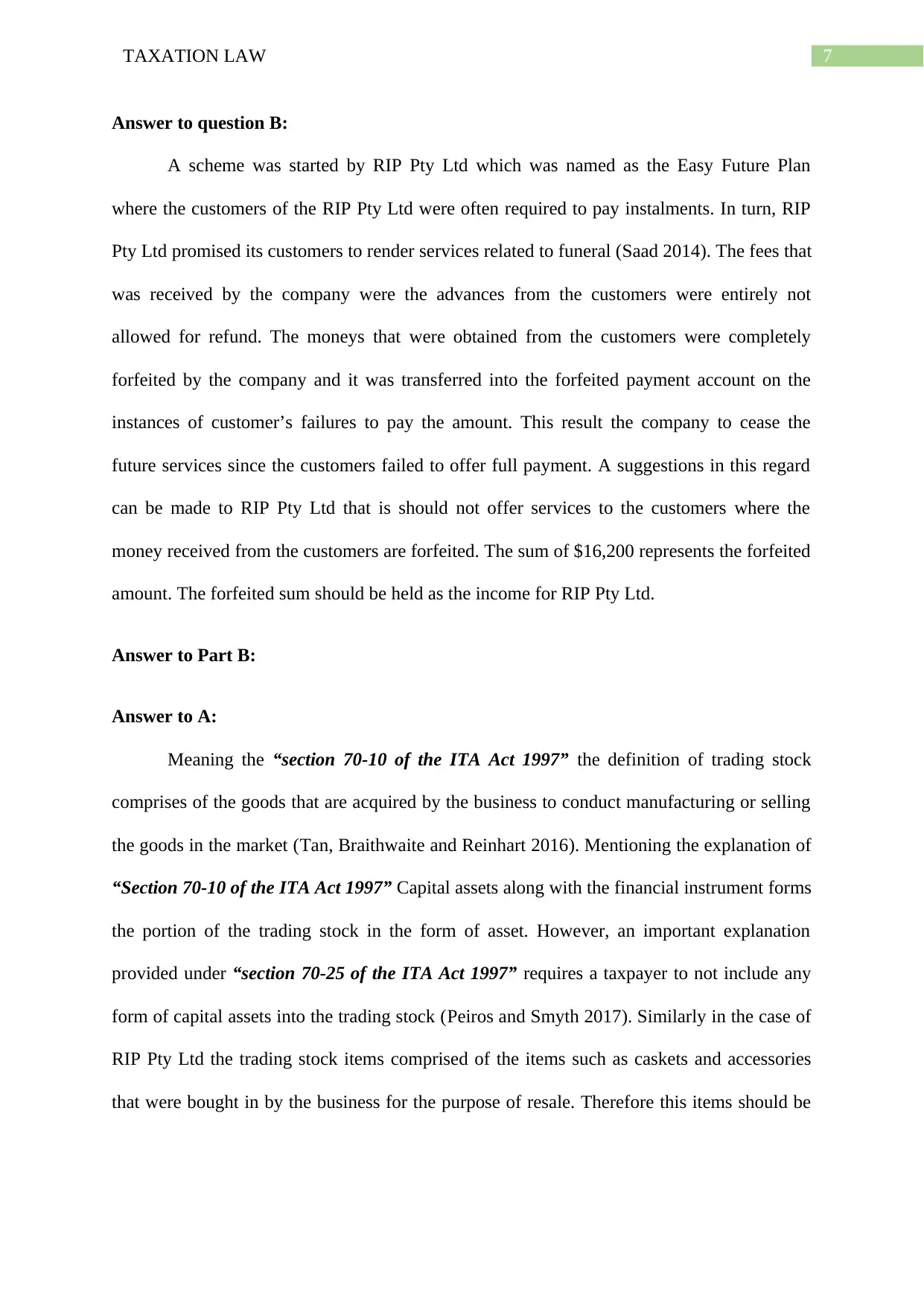
7TAXATION LAW
Answer to question B:
A scheme was started by RIP Pty Ltd which was named as the Easy Future Plan
where the customers of the RIP Pty Ltd were often required to pay instalments. In turn, RIP
Pty Ltd promised its customers to render services related to funeral (Saad 2014). The fees that
was received by the company were the advances from the customers were entirely not
allowed for refund. The moneys that were obtained from the customers were completely
forfeited by the company and it was transferred into the forfeited payment account on the
instances of customer’s failures to pay the amount. This result the company to cease the
future services since the customers failed to offer full payment. A suggestions in this regard
can be made to RIP Pty Ltd that is should not offer services to the customers where the
money received from the customers are forfeited. The sum of $16,200 represents the forfeited
amount. The forfeited sum should be held as the income for RIP Pty Ltd.
Answer to Part B:
Answer to A:
Meaning the “section 70-10 of the ITA Act 1997” the definition of trading stock
comprises of the goods that are acquired by the business to conduct manufacturing or selling
the goods in the market (Tan, Braithwaite and Reinhart 2016). Mentioning the explanation of
“Section 70-10 of the ITA Act 1997” Capital assets along with the financial instrument forms
the portion of the trading stock in the form of asset. However, an important explanation
provided under “section 70-25 of the ITA Act 1997” requires a taxpayer to not include any
form of capital assets into the trading stock (Peiros and Smyth 2017). Similarly in the case of
RIP Pty Ltd the trading stock items comprised of the items such as caskets and accessories
that were bought in by the business for the purpose of resale. Therefore this items should be
Answer to question B:
A scheme was started by RIP Pty Ltd which was named as the Easy Future Plan
where the customers of the RIP Pty Ltd were often required to pay instalments. In turn, RIP
Pty Ltd promised its customers to render services related to funeral (Saad 2014). The fees that
was received by the company were the advances from the customers were entirely not
allowed for refund. The moneys that were obtained from the customers were completely
forfeited by the company and it was transferred into the forfeited payment account on the
instances of customer’s failures to pay the amount. This result the company to cease the
future services since the customers failed to offer full payment. A suggestions in this regard
can be made to RIP Pty Ltd that is should not offer services to the customers where the
money received from the customers are forfeited. The sum of $16,200 represents the forfeited
amount. The forfeited sum should be held as the income for RIP Pty Ltd.
Answer to Part B:
Answer to A:
Meaning the “section 70-10 of the ITA Act 1997” the definition of trading stock
comprises of the goods that are acquired by the business to conduct manufacturing or selling
the goods in the market (Tan, Braithwaite and Reinhart 2016). Mentioning the explanation of
“Section 70-10 of the ITA Act 1997” Capital assets along with the financial instrument forms
the portion of the trading stock in the form of asset. However, an important explanation
provided under “section 70-25 of the ITA Act 1997” requires a taxpayer to not include any
form of capital assets into the trading stock (Peiros and Smyth 2017). Similarly in the case of
RIP Pty Ltd the trading stock items comprised of the items such as caskets and accessories
that were bought in by the business for the purpose of resale. Therefore this items should be
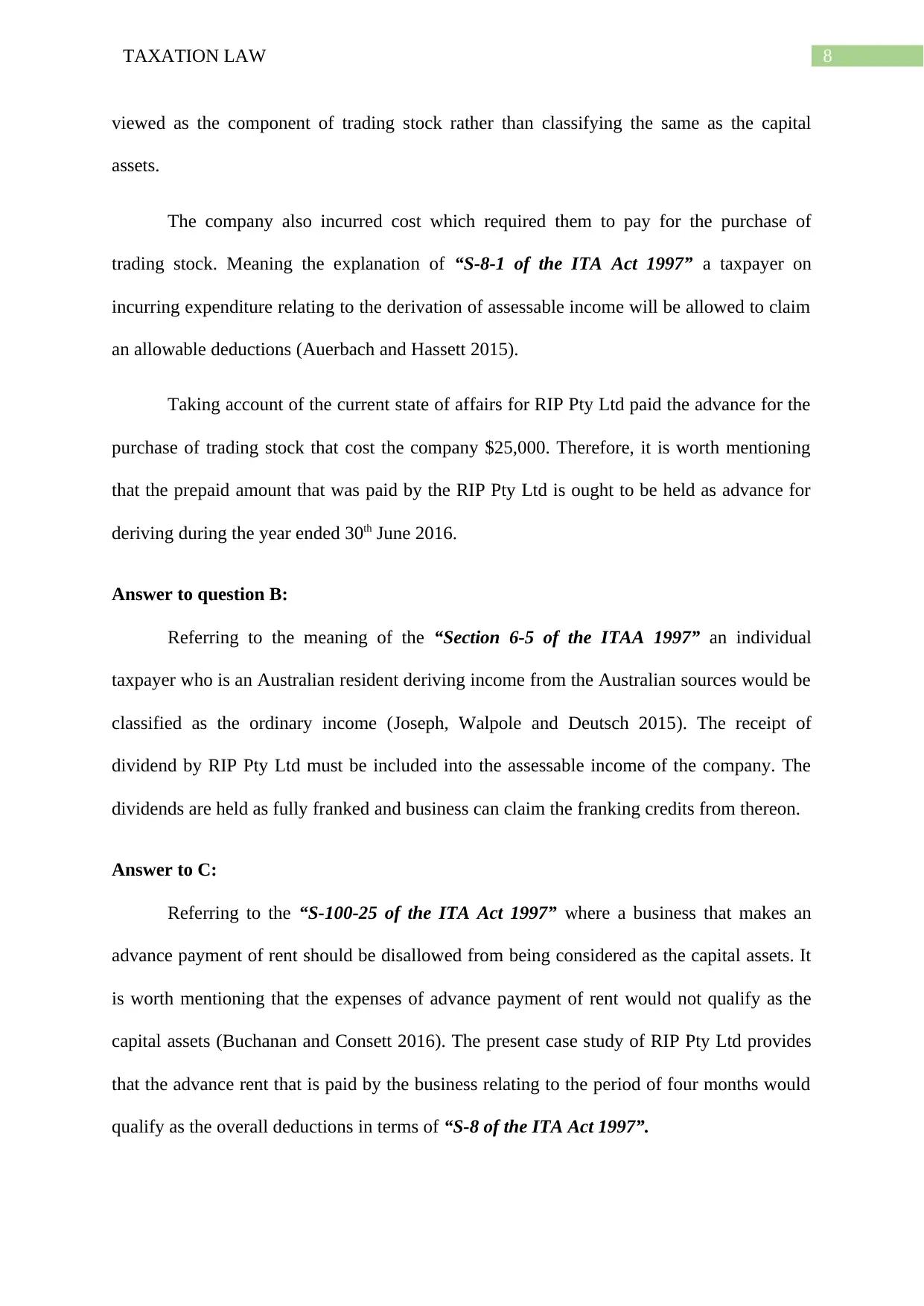
8TAXATION LAW
viewed as the component of trading stock rather than classifying the same as the capital
assets.
The company also incurred cost which required them to pay for the purchase of
trading stock. Meaning the explanation of “S-8-1 of the ITA Act 1997” a taxpayer on
incurring expenditure relating to the derivation of assessable income will be allowed to claim
an allowable deductions (Auerbach and Hassett 2015).
Taking account of the current state of affairs for RIP Pty Ltd paid the advance for the
purchase of trading stock that cost the company $25,000. Therefore, it is worth mentioning
that the prepaid amount that was paid by the RIP Pty Ltd is ought to be held as advance for
deriving during the year ended 30th June 2016.
Answer to question B:
Referring to the meaning of the “Section 6-5 of the ITAA 1997” an individual
taxpayer who is an Australian resident deriving income from the Australian sources would be
classified as the ordinary income (Joseph, Walpole and Deutsch 2015). The receipt of
dividend by RIP Pty Ltd must be included into the assessable income of the company. The
dividends are held as fully franked and business can claim the franking credits from thereon.
Answer to C:
Referring to the “S-100-25 of the ITA Act 1997” where a business that makes an
advance payment of rent should be disallowed from being considered as the capital assets. It
is worth mentioning that the expenses of advance payment of rent would not qualify as the
capital assets (Buchanan and Consett 2016). The present case study of RIP Pty Ltd provides
that the advance rent that is paid by the business relating to the period of four months would
qualify as the overall deductions in terms of “S-8 of the ITA Act 1997”.
viewed as the component of trading stock rather than classifying the same as the capital
assets.
The company also incurred cost which required them to pay for the purchase of
trading stock. Meaning the explanation of “S-8-1 of the ITA Act 1997” a taxpayer on
incurring expenditure relating to the derivation of assessable income will be allowed to claim
an allowable deductions (Auerbach and Hassett 2015).
Taking account of the current state of affairs for RIP Pty Ltd paid the advance for the
purchase of trading stock that cost the company $25,000. Therefore, it is worth mentioning
that the prepaid amount that was paid by the RIP Pty Ltd is ought to be held as advance for
deriving during the year ended 30th June 2016.
Answer to question B:
Referring to the meaning of the “Section 6-5 of the ITAA 1997” an individual
taxpayer who is an Australian resident deriving income from the Australian sources would be
classified as the ordinary income (Joseph, Walpole and Deutsch 2015). The receipt of
dividend by RIP Pty Ltd must be included into the assessable income of the company. The
dividends are held as fully franked and business can claim the franking credits from thereon.
Answer to C:
Referring to the “S-100-25 of the ITA Act 1997” where a business that makes an
advance payment of rent should be disallowed from being considered as the capital assets. It
is worth mentioning that the expenses of advance payment of rent would not qualify as the
capital assets (Buchanan and Consett 2016). The present case study of RIP Pty Ltd provides
that the advance rent that is paid by the business relating to the period of four months would
qualify as the overall deductions in terms of “S-8 of the ITA Act 1997”.
⊘ This is a preview!⊘
Do you want full access?
Subscribe today to unlock all pages.

Trusted by 1+ million students worldwide
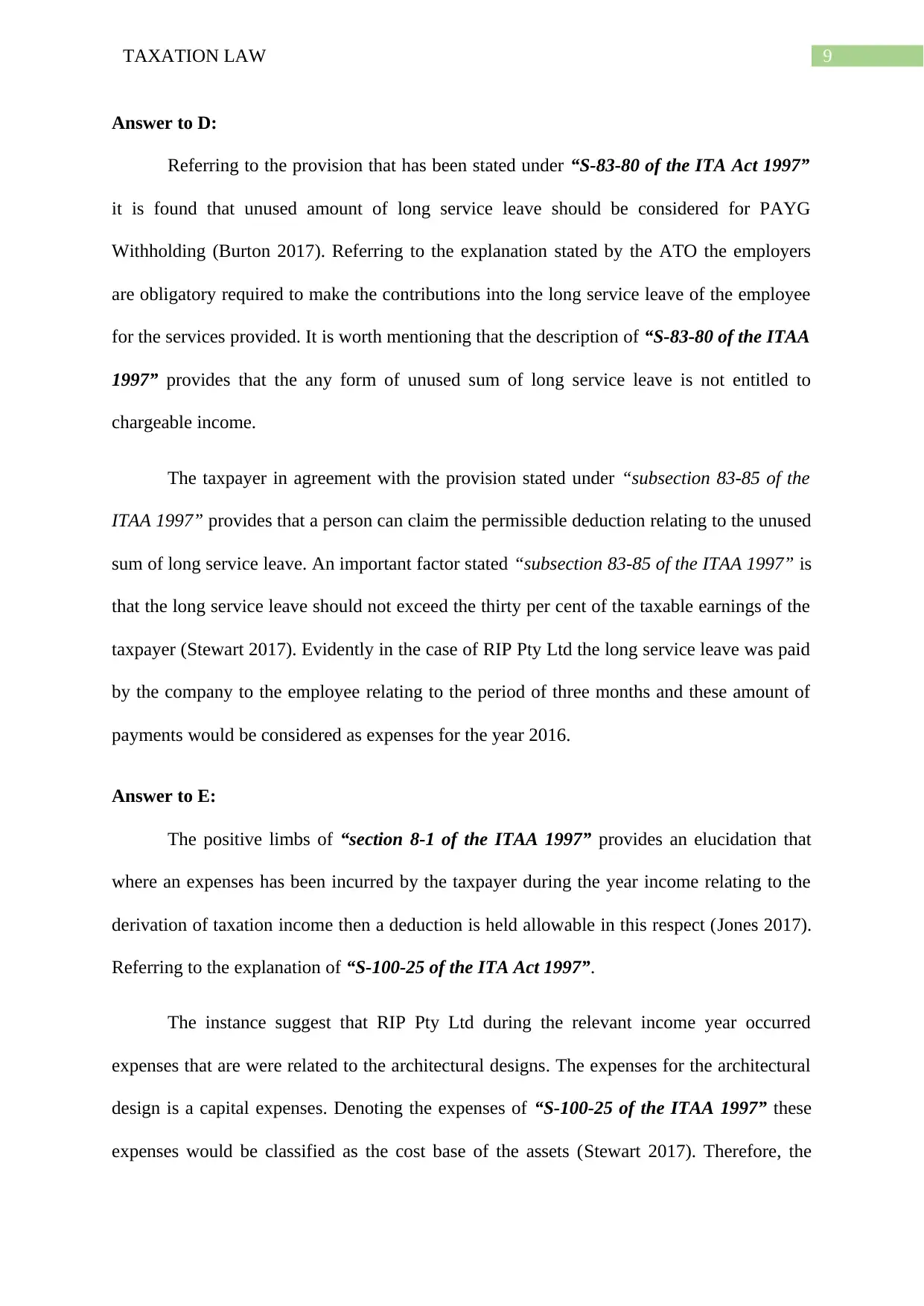
9TAXATION LAW
Answer to D:
Referring to the provision that has been stated under “S-83-80 of the ITA Act 1997”
it is found that unused amount of long service leave should be considered for PAYG
Withholding (Burton 2017). Referring to the explanation stated by the ATO the employers
are obligatory required to make the contributions into the long service leave of the employee
for the services provided. It is worth mentioning that the description of “S-83-80 of the ITAA
1997” provides that the any form of unused sum of long service leave is not entitled to
chargeable income.
The taxpayer in agreement with the provision stated under “subsection 83-85 of the
ITAA 1997” provides that a person can claim the permissible deduction relating to the unused
sum of long service leave. An important factor stated “subsection 83-85 of the ITAA 1997” is
that the long service leave should not exceed the thirty per cent of the taxable earnings of the
taxpayer (Stewart 2017). Evidently in the case of RIP Pty Ltd the long service leave was paid
by the company to the employee relating to the period of three months and these amount of
payments would be considered as expenses for the year 2016.
Answer to E:
The positive limbs of “section 8-1 of the ITAA 1997” provides an elucidation that
where an expenses has been incurred by the taxpayer during the year income relating to the
derivation of taxation income then a deduction is held allowable in this respect (Jones 2017).
Referring to the explanation of “S-100-25 of the ITA Act 1997”.
The instance suggest that RIP Pty Ltd during the relevant income year occurred
expenses that are were related to the architectural designs. The expenses for the architectural
design is a capital expenses. Denoting the expenses of “S-100-25 of the ITAA 1997” these
expenses would be classified as the cost base of the assets (Stewart 2017). Therefore, the
Answer to D:
Referring to the provision that has been stated under “S-83-80 of the ITA Act 1997”
it is found that unused amount of long service leave should be considered for PAYG
Withholding (Burton 2017). Referring to the explanation stated by the ATO the employers
are obligatory required to make the contributions into the long service leave of the employee
for the services provided. It is worth mentioning that the description of “S-83-80 of the ITAA
1997” provides that the any form of unused sum of long service leave is not entitled to
chargeable income.
The taxpayer in agreement with the provision stated under “subsection 83-85 of the
ITAA 1997” provides that a person can claim the permissible deduction relating to the unused
sum of long service leave. An important factor stated “subsection 83-85 of the ITAA 1997” is
that the long service leave should not exceed the thirty per cent of the taxable earnings of the
taxpayer (Stewart 2017). Evidently in the case of RIP Pty Ltd the long service leave was paid
by the company to the employee relating to the period of three months and these amount of
payments would be considered as expenses for the year 2016.
Answer to E:
The positive limbs of “section 8-1 of the ITAA 1997” provides an elucidation that
where an expenses has been incurred by the taxpayer during the year income relating to the
derivation of taxation income then a deduction is held allowable in this respect (Jones 2017).
Referring to the explanation of “S-100-25 of the ITA Act 1997”.
The instance suggest that RIP Pty Ltd during the relevant income year occurred
expenses that are were related to the architectural designs. The expenses for the architectural
design is a capital expenses. Denoting the expenses of “S-100-25 of the ITAA 1997” these
expenses would be classified as the cost base of the assets (Stewart 2017). Therefore, the
Paraphrase This Document
Need a fresh take? Get an instant paraphrase of this document with our AI Paraphraser
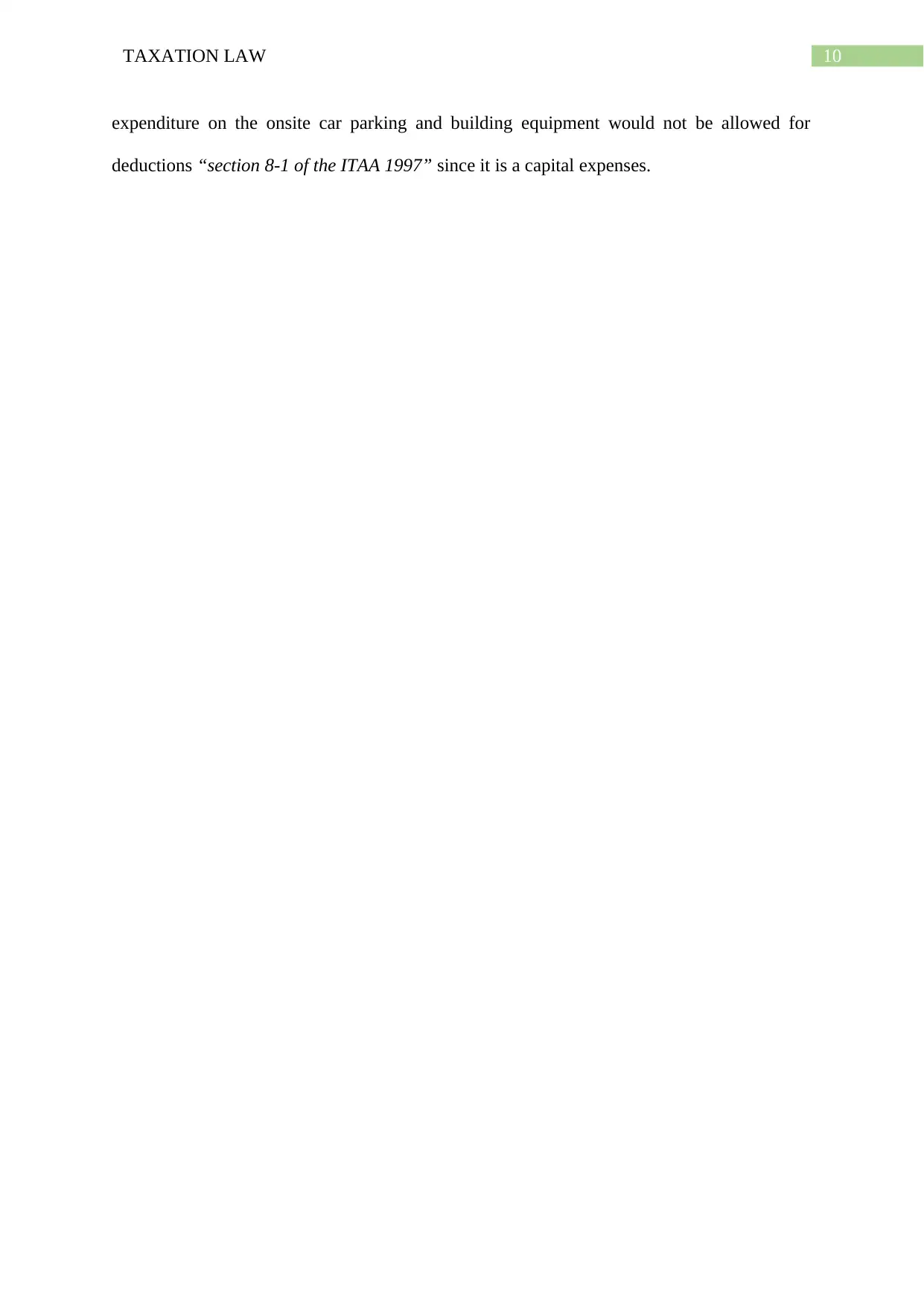
10TAXATION LAW
expenditure on the onsite car parking and building equipment would not be allowed for
deductions “section 8-1 of the ITAA 1997” since it is a capital expenses.
expenditure on the onsite car parking and building equipment would not be allowed for
deductions “section 8-1 of the ITAA 1997” since it is a capital expenses.
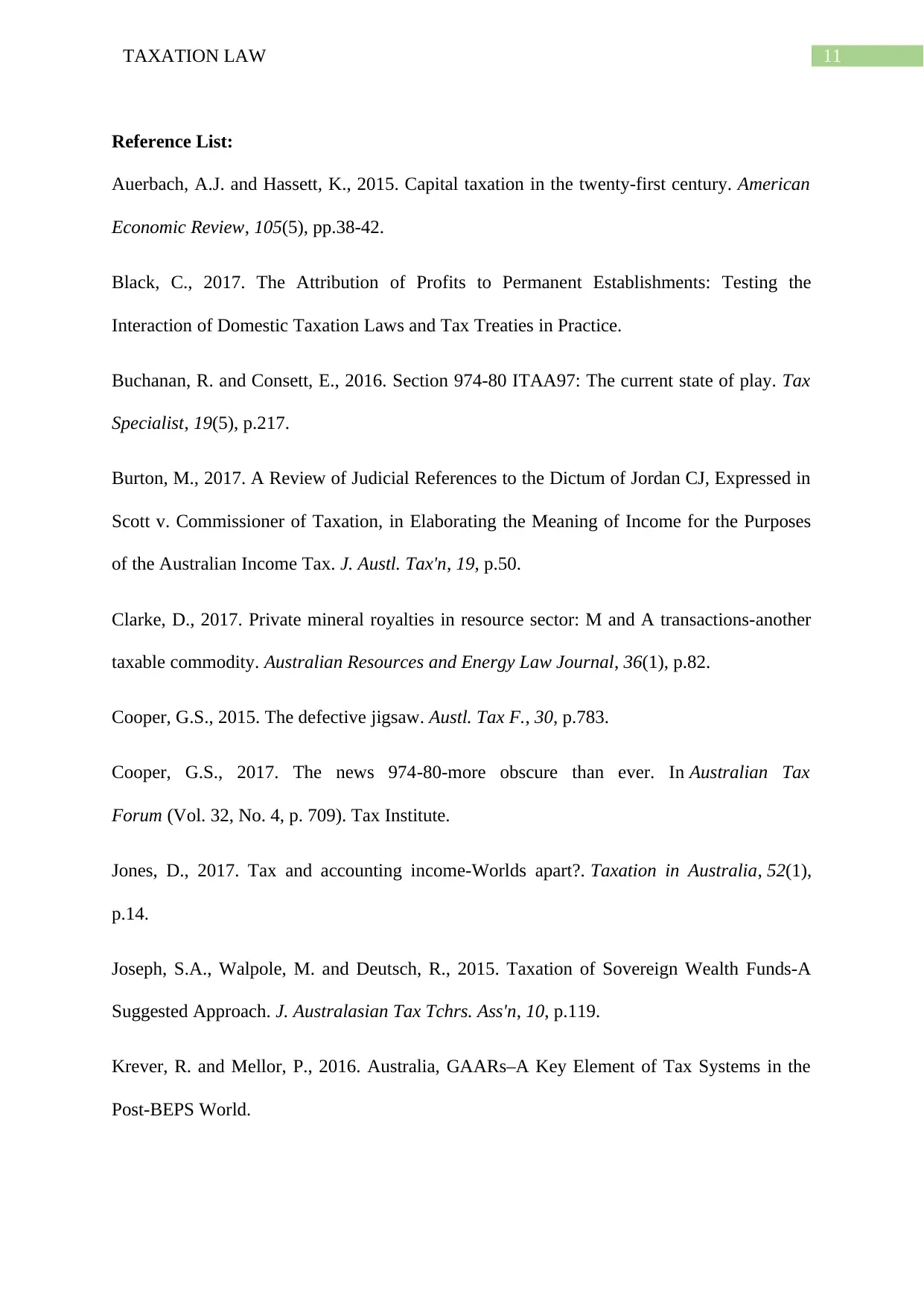
11TAXATION LAW
Reference List:
Auerbach, A.J. and Hassett, K., 2015. Capital taxation in the twenty-first century. American
Economic Review, 105(5), pp.38-42.
Black, C., 2017. The Attribution of Profits to Permanent Establishments: Testing the
Interaction of Domestic Taxation Laws and Tax Treaties in Practice.
Buchanan, R. and Consett, E., 2016. Section 974-80 ITAA97: The current state of play. Tax
Specialist, 19(5), p.217.
Burton, M., 2017. A Review of Judicial References to the Dictum of Jordan CJ, Expressed in
Scott v. Commissioner of Taxation, in Elaborating the Meaning of Income for the Purposes
of the Australian Income Tax. J. Austl. Tax'n, 19, p.50.
Clarke, D., 2017. Private mineral royalties in resource sector: M and A transactions-another
taxable commodity. Australian Resources and Energy Law Journal, 36(1), p.82.
Cooper, G.S., 2015. The defective jigsaw. Austl. Tax F., 30, p.783.
Cooper, G.S., 2017. The news 974-80-more obscure than ever. In Australian Tax
Forum (Vol. 32, No. 4, p. 709). Tax Institute.
Jones, D., 2017. Tax and accounting income-Worlds apart?. Taxation in Australia, 52(1),
p.14.
Joseph, S.A., Walpole, M. and Deutsch, R., 2015. Taxation of Sovereign Wealth Funds-A
Suggested Approach. J. Australasian Tax Tchrs. Ass'n, 10, p.119.
Krever, R. and Mellor, P., 2016. Australia, GAARs–A Key Element of Tax Systems in the
Post-BEPS World.
Reference List:
Auerbach, A.J. and Hassett, K., 2015. Capital taxation in the twenty-first century. American
Economic Review, 105(5), pp.38-42.
Black, C., 2017. The Attribution of Profits to Permanent Establishments: Testing the
Interaction of Domestic Taxation Laws and Tax Treaties in Practice.
Buchanan, R. and Consett, E., 2016. Section 974-80 ITAA97: The current state of play. Tax
Specialist, 19(5), p.217.
Burton, M., 2017. A Review of Judicial References to the Dictum of Jordan CJ, Expressed in
Scott v. Commissioner of Taxation, in Elaborating the Meaning of Income for the Purposes
of the Australian Income Tax. J. Austl. Tax'n, 19, p.50.
Clarke, D., 2017. Private mineral royalties in resource sector: M and A transactions-another
taxable commodity. Australian Resources and Energy Law Journal, 36(1), p.82.
Cooper, G.S., 2015. The defective jigsaw. Austl. Tax F., 30, p.783.
Cooper, G.S., 2017. The news 974-80-more obscure than ever. In Australian Tax
Forum (Vol. 32, No. 4, p. 709). Tax Institute.
Jones, D., 2017. Tax and accounting income-Worlds apart?. Taxation in Australia, 52(1),
p.14.
Joseph, S.A., Walpole, M. and Deutsch, R., 2015. Taxation of Sovereign Wealth Funds-A
Suggested Approach. J. Australasian Tax Tchrs. Ass'n, 10, p.119.
Krever, R. and Mellor, P., 2016. Australia, GAARs–A Key Element of Tax Systems in the
Post-BEPS World.
⊘ This is a preview!⊘
Do you want full access?
Subscribe today to unlock all pages.

Trusted by 1+ million students worldwide
1 out of 14
Related Documents
Your All-in-One AI-Powered Toolkit for Academic Success.
+13062052269
info@desklib.com
Available 24*7 on WhatsApp / Email
![[object Object]](/_next/static/media/star-bottom.7253800d.svg)
Unlock your academic potential
Copyright © 2020–2025 A2Z Services. All Rights Reserved. Developed and managed by ZUCOL.





